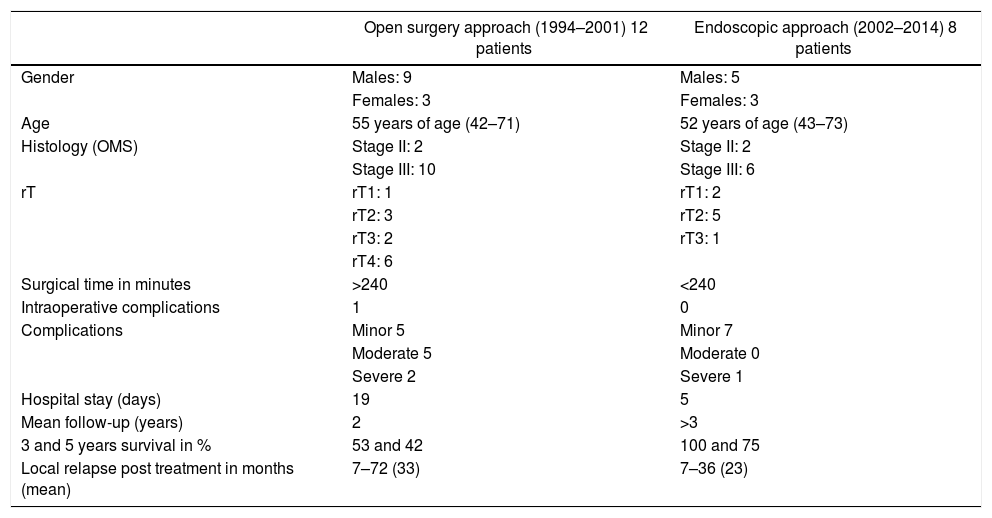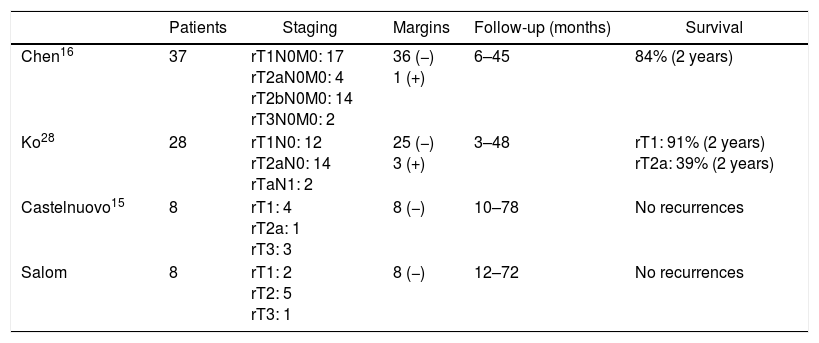Chemoradiotherapy is the treatment of choice for nasopharyngeal carcinoma. Local recurrences are one of the leading causes of death in these patients, and surgical salvage the treatment of choice. Our goal was to evaluate and compare the results of salvage surgery in the treatment of local recurrence of nasopharyngeal carcinomas comparing endoscopic to open approaches.
MethodsTwenty patients with local recurrence of nasopharyngeal carcinomas underwent surgery: 12 patients underwent open surgery and 8 endoscopic endonasal transpterygoid nasopharyngectomy. One patient was classified as rT1, three as rT2, two as rT3, and six as rT4 in the group of open approaches; in the endoscopic series, two patients were rT1, five rT2 and one rT3.
ResultsIn 3 patients (25%) operated by an open approach (one rT4, one rT3 and one rT2) a complete gross resection was not achieved. Gross total resection was achieved in patients operated by endoscopic surgery. The complication rate in the group operated by an open approach was 92% (five minor complications, five moderate complications, and one serious complication) and in the group that underwent endoscopic surgery all patients had some complication (seven had minor complications and one patient developed a severe complication). Survival at 3 and 5 years was 53% and 42% with the open approach and 100% and 50% with the endoscopic approach, respectively.
ConclusionsEndoscopic approaches decrease the morbidity associated with open approaches and allow for favourable oncological control.
La quimiorradioterapia es el tratamiento de elección del carcinoma de nasofaringe. Las recurrencias locales son una de las principales causas de mortalidad en estos pacientes: el rescate quirúrgico o la reirradiación son el tratamiento de elección, según la disponibilidad. El objetivo fue evaluar y comparar los resultados de la cirugía de rescate en el tratamiento de las recidivas locales de los carcinomas nasofaríngeos mediante abordajes abiertos vs. endoscópicos.
MétodosVeinte pacientes con recidivas locales de carcinomas nasofaríngeos fueron intervenidos quirúrgicamente: 12 pacientes fueron intervenidos mediante cirugía abierta y 8 mediante un abordaje endoscópico endonasal transpterigoideo. Un paciente fue estadiado como rT1; 3 como rT2; 2 como rT3 y 6 como rT4 en el grupo de abordajes abiertos; en la serie endoscópica, 2 pacientes fueron rT1, 5 fueron rT2 y uno fue rT3.
ResultadosEn 3 de los pacientes (25%) intervenidos mediante cirugía abierta (un rT4, un rT3 y un rT2) no se logró una resección macroscópica completa). En el grupo endoscópico la resección fue completa en todos los pacientes. La tasa de complicaciones en el grupo intervenido mediante abordajes abiertos fue del 92% (5 complicaciones leves, 5 complicaciones moderadas y una complicación grave) y en el grupo intervenido mediante endoscopia fue del 100% (7 sufrieron complicaciones leves y un paciente una complicación grave). La supervivencia a los 3 y 5 años fue del 53 y del 42% en el abordaje abierto y del 100 y del 75% en el abordaje endoscópico, respectivamente.
ConclusionesLos abordajes endoscópicos disminuyen la morbilidad asociada a los abordajes abiertos y permiten obtener un control oncológico favorable.
Artículo
Comprando el artículo el PDF del mismo podrá ser descargado
Precio 19,34 €
Comprar ahora








